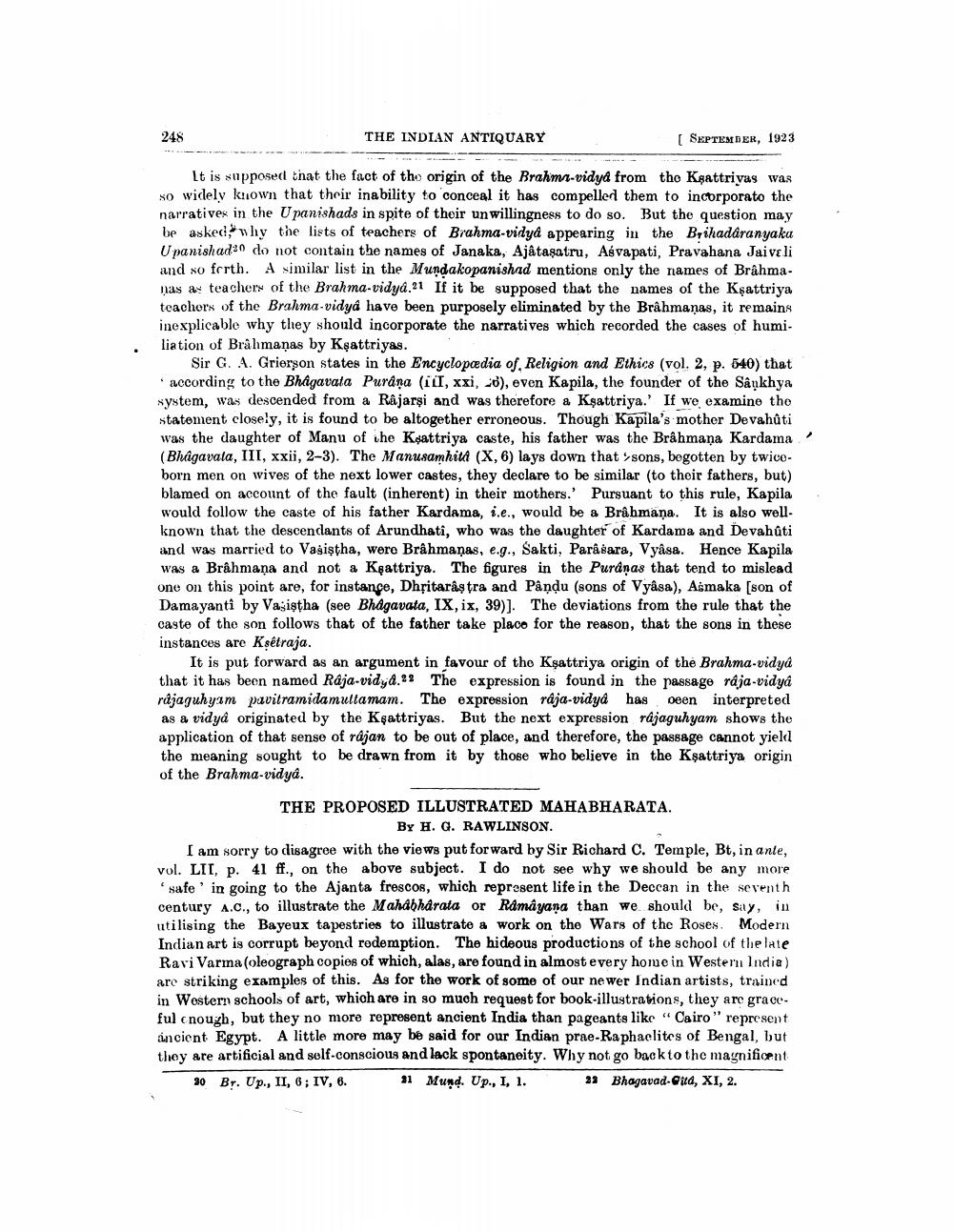________________
248
THE INDIAN ANTIQUARY
( SEPTEMDER, 1923
It is supposed that the fact of the origin of the Brahmi-vidyd from tho Kşattriyas was so widely known that their inability to conceal it has compelled them to incorporato the narratives in the Upanishads in spite of their unwillingness to do so. But the question may be asked," why the lists of teachers of Brahma-vidya appearing in the Brihadaranyaku Upanishad20 do not contain the names of Janaka, Ajậtasatru, Asvapati, Pravahana Jaiveli and so forth. A similar list in the Mundakopanishad mentions only the names of Brâhmanas a teachers of the Brahma-vidyd.21 If it be supposed that the names of the Kşattriya teachers of the Brahma-vidyd have been purposely eliminated by the Brâhmaņas, it remains inexplicable why they should incorporate the narratives which recorded the cases of humiliation of Brahmaņas by Kşattriyas.
Sir G. A. Grierson states in the Encyclopædia of, Religion and Ethics (vol. 2, p. 540) that according to the Bhagavata Purana (il, xxi, 26), even Kapila, the founder of the Sânkhya system, was descended from a Râ jarşi and was therefore a Kşattriya.' If we examine the statement closely, it is found to be altogether erroneous. Though Kapila's mother Devahûti was the daughter of Manu of ihe Ksattriya caste, his father was the Brâhmana Kardama (Bhagavala, III, xxii, 2-3). The Manusamhita (X, 6) lays down that %sons, begotten by twiceborn men on wives of the next lower castes, they declare to be similar to their fathers, but) blamed on account of the fault inherent) in their mothers.' Pursuant to this rule, Kapila would follow the caste of his father Kardama, i.e., would be a Brahmana. It is also wellknown that the descendants of Arundhati, who was the daughter of Kardama and Devahûti and was married to Vagiştha, were Brâhmaņas, e.g., Sakti, Paragara, Vyâsa. Hence Kapila was a Brahmana and not a Kşattriya. The figures in the Puranas that tend to mislead one on this point are, for instance, Dhřitaraş tra and Pându (sons of Vyâsa), Asmaka (son of Damayanti by Vašiştha (see Bhagavata, IX, ix, 39)]. The deviations from the rule that the caste of the son follows that of the father take place for the reason, that the sons in these instances are Ksétraja.
It is put forward as an argument in favour of the Kşattriya origin of the Brahma-vidyd that it has been named Raja-vidya.22 The expression is found in the passage raja-vidya rdjaguhyam pavitramidamultamam. The expression raja-vidya has been interpreted as a vidya originated by the Kşattriyas. But the next expression rajaguhyam shows the application of that sense of rajan to be out of place, and therefore, the passage cannot yield the meaning sought to be drawn from it by those who believe in the Kşattriya origin of the Brahma-vidya.
THE PROPOSED ILLUSTRATED MAHABHARATA.
BY H. G. RAWLINSON. I am sorry to disagree with the views put forward by Sir Richard C. Temple, Bt, in ante, vol. LII, p. 41 ff., on the above subject. I do not see why we should be any more
safe in going to the Ajanta frescos, which represent life in the Deccan in the seventh century A.C., to illustrate the Mahabharata or Ramayana than we should be, say, in utilising the Bayeux tapestries to illustrate a work on the Wars of the Roses Modern Indian art is corrupt beyond redemption. The hideous productions of the school of the late Ravi Varma (oleograph copies of which, alas, are found in almost every home in Western India) are striking examples of this. As for the work of some of our newer Indian artists, trained in Western schools of art, which are in so much request for book-illustrations, they are graceful cnough, but they no more represent ancient India than pageants like “Cairo" represent incient Egypt. A little more may be said for our Indian prae-Raphaelites of Bengal, but they are artificial and self-conscious and lack spontaneity. Why not go backto the magnificent
20 Br. Up., II, 6; IV, 6. 31 Mund. Up., I, I. 39 Bhagavad-Gita, XI, 2.




